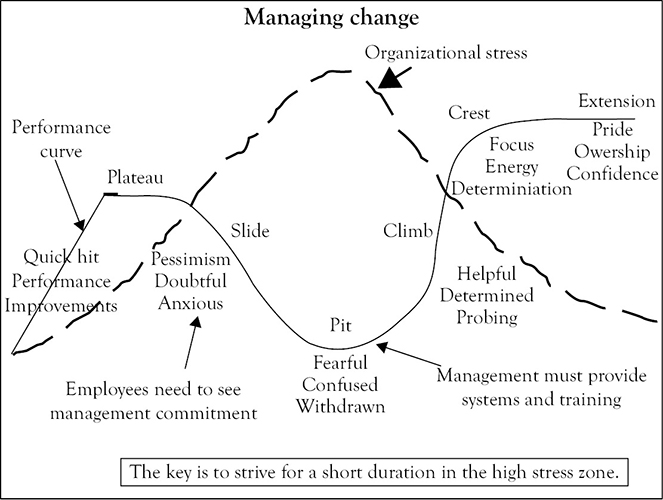Achieving, Sustaining, and Celebrating Sales Success
Bill had been working on the Lean Sigma improvements for nearly two years, and was invited to Rapid Products’s annual Supplier Day to present his success story. During a break in the sessions, Ray caught up to Bill and asked the following.
“We’ve been doing this Lean Sigma thing for nearly six years now and have made some great progress. We are actually growing now, and becoming quite profitable. But the teams are losing their enthusiasm and the whole thing is starting to seem stale. Any hints on how to re-energize the teams?” asked Ray.
“We always go back to the basics to recharge our teams. It’s important to show your commitment. Remember the key enablers? Ask yourself what, if anything is missing?” Bill replied.
Key Enablers for Lean Sigma Success:
1. Leadership establishing, communicating, and living up to the vision, mission, and values
2. Resource commitment
3. Training and education
4. Process and results focused
5. Policy deployment and goal alignment
6. Total system or value stream focus
7. Employee involvement
8. Perseverance and commitment
Source: Lean Thinking and PPS.
Bill continued, “We also try to come up with some new challenges or themes to keep things fresh. One time when we set new goals for sales, everyone cried that ‘We can’t get any more work with the economy in a dead fall!’ So we told the teams that when we meet the new goals, we would celebrate by having the management team wash their cars. The winning team would get free car washes for a year. This really got the teams fired-up, and we had a lot of fun with the challenge. In fact, when the managers were washing cars, a local newspaper reported on it, and everyone enjoyed seeing an article about how fun it is to work at Rapid Products. Our customers also took note as well. That was quite a fun celebration.”
“We then created another theme to push accomplishment even farther. We created a competition within the organization, and the winning team with the most improvements would get a free vacation day. Again we had a lot of fun with this. It took about a year to achieve the goal, but we succeeded in raising the bar of achievement. You might try a theme or a challenge, or internal competition to get some excitement back into the improvement effort,” explained Bill.
“When you’re managing change in an organization, things can get difficult,” continued Bill. Bill sketched the following illustration on the white board, and explained. “You see, at first, once everyone sees that you’re serious about improving, and gets over the shock and denial, people begin to see how the Lean Sigma improvements can help them. They start to see some quick hitting improvements, and are optimistic. Then, when the ‘low hanging fruit’ or easy projects have been implemented, things get tougher, and improvements are harder to find. When this happens, things start to plateau or level out. If left alone, this plateau will turn into pessimism and doubt. At this point people need to see management’s commitment to Lean Sigma methods and tools. Too many leaders throw in the towel at this point, and say Lean Sigma doesn’t work.
If managers and leaders redouble their efforts and commitments at this point, things will start to turn around, and many more significant gains will occur. The key is to push through the trough or ‘organizational stress’ as quickly as possible, by sticking to key projects and the Lean Sigma methods and tools.”
Ray said, “That’s interesting, but I think we are beyond that now, and I just want to get some more excitement around the pigments plus. I think a challenge—something big, will be a good way to get the excitement back.”

“In Jim Collins’s book Good to Great, he called them Big Hairy Audacious Goals (BHAGs), and many organizations have them. They provide long-term focus and can be fun,” Bill added.
“Another key is to continue to hold people accountable to use the Lean Sigma methods and tools. This should be built right into your performance management system. Keep to the accountability sessions or Meeting Rhythms as Harnish called them in his book Mastering the Rockefeller Habits. In the book, Harnish describes a meeting rhythm with daily huddles, weekly, monthly, and quarterly work sessions to review progress to goals, ensure resources are provided, and to hold people and teams accountable for results. This is a key to sustaining the effort. Make these regular work sessions have standard work for you and your area leaders. Perform layered process audits to make sure they are doing them, and doing them correctly. This will let the teams see that these are important to you, and to their success,” Bill added.
“Boy, sustaining the effort is hard work!” replied Ray “and you’ve really become quite the expert. Nice work Bill, and thanks for your help,” Ray concluded.
“Well Ray, you helped me when I needed it, and as you know, and Lean Sigma philosophy is to share the knowledge. It’s the least I could do.”
Discussion Questions
1. What do you think of Bill’s statement that “We always go back to the basics to recharge our team?” Why do you think it is important to go back to the basics and to remember the key enablers?
2. Do you agree with Bill that, “We also try to come up with some new challenges or themes to keep things fresh.” What does your organization do in this area?
3. Why is it critical for an organization to hold people accountable to use the Lean Sigma methods and tools? What does your organization do to make their people accountable?
